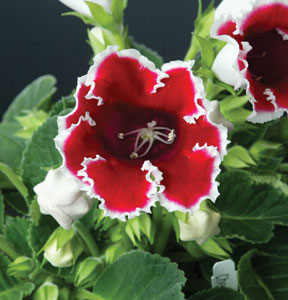11/15/2009
Growing Great Gloxinias
Bill Aulenbach

Gloxinias are a pot crop that offers consumers both lovely colors and an intriguing flower shape. For the best crop possible, follow these cultural guidelines.
Receiving. Unpack gloxinia plugs immediately and place them in the greenhouse. Check for dryness and water if needed. Try to plant the plugs within one or two days. Waiting much longer may stunt growth and cause premature flowering if the plugs remain in the plug tray for an extended period.
Planting. Plant gloxinias deeply. Only ¼ in. to ½ in. of the growing tip and two pairs of leaves should be visible. Plants not planted deeply enough will flop or have a leggy finished appearance. Avoid packing the media when planting. This may result in poor root development and stunted growth.
Media. Gloxinias have a fine root system, requiring them to have a well-drained media. Most well-draining, commercial soilless media should be appropriate. Maintain media pH between 5.8 and 6.2.
Irrigation. Determine the water quality (alkalinity, nutrient content and so on) to evaluate its potential effects on pH and plant nutrient availability. Water regularly, but don’t overwater. Water on gloxinia foliage isn’t harmful unless the water is below 50F (10C). Water early in the day to prevent wet foliage overnight.
Fertility. Gloxinias require moderate fertilization. Use Peat-Lite fertilizers such as 15-16-17 or 20-10-20 alternated with calcium nitrate-based fertilizers (15-0-15 or 17-5-17). Avoid high ammonia-type fertilizers such as 20-20-20 and MagAmp. Use 250 to 350 ppm nitrogen every second or third watering. Constant liquid fertilization of 125 to 175 ppm nitrogen can also be used. Lower rates during winter. Gloxinias also do well with controlled-release fertilizers such as Osmocote 14-14-14 or 19-6-12 at low-labeled rates with supplemental liquid fertilizer as needed. Some signs of excessive fertilizer (particularly nitrogen) include twisted, curled or cupped foliage or hard, brittle blue-green foliage. Yellow foliage indicates insufficient nutrition.
Light. Maintain light levels at 2,000 to 3,000 footcandles. Apply extra shade beginning in mid-March (South) or early April (North) to reduce light intensity. You may need up to 60% shade depending on your type of greenhouse cover. Excessive light of 3,500 footcandles or more can cause hardened, yellow foliage and small, gray-brown spots, as well as premature budding with excessive temperatures. Too little light will result in leggy plants with few flowers.
Temperature. Maintain temperature between 60F and 65F (15C and 18C) at night and between 75F and 85F (24C and 29C) during the day. If plants are flowering too early, lower temperatures to 52F to 55F (11C to 13C) to slow development. Temperatures below 50F (10C) can cause yellow or brown leaf spots.
Height Control. Apply a light foliar spray of 1,250 ppm B-Nine when the first leaf pair reaches the edge of the pot (eight to 18 days after planting). A second application can be made seven to 10 days later for plants grown in low light levels. Don’t apply B-Nine later than four weeks after planting, since it may delay flowering. A 30 ppm Bonzi spray one to two weeks before flowering can be used if plants are growing larger than desired.
Insects and Diseases. Mites can cause new center growth to turn slightly dark bronze and hard. Foliar sprays of Pylon, Avid and Floramite can be used. Thrips can also cause major damage to gloxinias. They cause distortion of the growing tip and streak marks on flowers, and also carry TSWV or INSV. Thrips are hard to detect on gloxinias not in flower. They usually bury themselves in the crown. Use Conserve to reduce high numbers of thrips, then follow up with sprays of Avid, Talstar and Sanmite as needed.
Apply a fungicide drench one to two days after planting. Use a combination of 16 oz. of Cleary’s 3336 and ½ oz. Subdue MAXX per 100 gal. of water or Banrot at 8 oz. per 100 gal. of water. Apply a second fungicide drench four to six weeks later to prevent root diseases during finishing. Apply a light foliar rinse to remove any fungicide residue after application to reduce possible injury to foliage. Also, provide good air circulation to prevent leaf diseases. Always follow pesticide label directions.
Bill Aulenbach is technical support manager for Green Leaf Plants potted plant products.